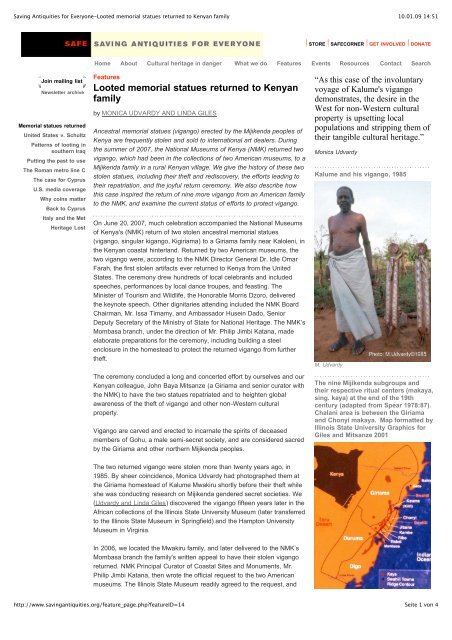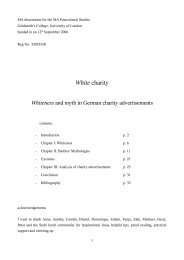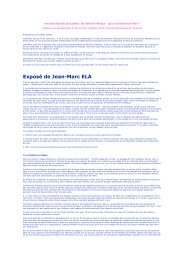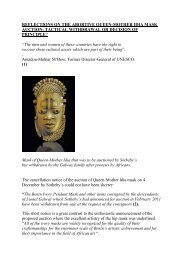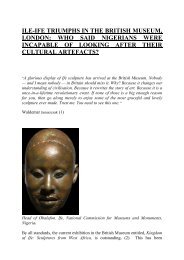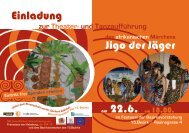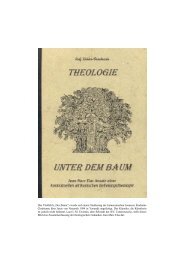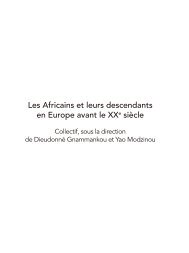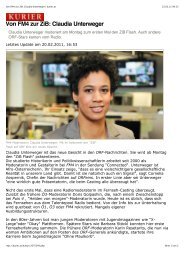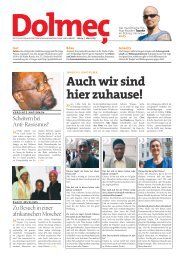Saving Antiquities for Everyone-Looted memorial ... - Afrikanet.info
Saving Antiquities for Everyone-Looted memorial ... - Afrikanet.info
Saving Antiquities for Everyone-Looted memorial ... - Afrikanet.info
- No tags were found...
Create successful ePaper yourself
Turn your PDF publications into a flip-book with our unique Google optimized e-Paper software.
<strong>Saving</strong> <strong>Antiquities</strong> <strong>for</strong> <strong>Everyone</strong>-<strong>Looted</strong> <strong>memorial</strong> statues returned to Kenyan family<br />
10.01.09 14:51<br />
STORE<br />
SAFECORNER<br />
GET INVOLVED<br />
DONATE<br />
Home About Cultural heritage in danger What we do Features Events Resources Contact Search<br />
Join mailing list<br />
Newsletter archive<br />
Memorial statues returned<br />
United States v. Schultz<br />
Patterns of looting in<br />
southern Iraq<br />
Putting the past to use<br />
The Roman metro line C<br />
The case <strong>for</strong> Cyprus<br />
U.S. media coverage<br />
Why coins matter<br />
Back to Cyprus<br />
Italy and the Met<br />
Heritage Lost<br />
Features<br />
<strong>Looted</strong> <strong>memorial</strong> statues returned to Kenyan<br />
family<br />
by MONICA UDVARDY AND LINDA GILES<br />
Ancestral <strong>memorial</strong> statues (vigango) erected by the Mijikenda peoples of<br />
Kenya are frequently stolen and sold to international art dealers. During<br />
the summer of 2007, the National Museums of Kenya (NMK) returned two<br />
vigango, which had been in the collections of two American museums, to a<br />
Mijikenda family in a rural Kenyan village. We give the history of these two<br />
stolen statues, including their theft and rediscovery, the ef<strong>for</strong>ts leading to<br />
their repatriation, and the joyful return ceremony. We also describe how<br />
this case inspired the return of nine more vigango from an American family<br />
to the NMK, and examine the current status of ef<strong>for</strong>ts to protect vigango.<br />
On June 20, 2007, much celebration accompanied the National Museums<br />
of Kenya's (NMK) return of two stolen ancestral <strong>memorial</strong> statues<br />
(vigango, singular kigango, Kigiriama) to a Giriama family near Kaloleni, in<br />
the Kenyan coastal hinterland. Returned by two American museums, the<br />
two vigango were, according to the NMK Director General Dr. Idle Omar<br />
Farah, the first stolen artifacts ever returned to Kenya from the United<br />
States. The ceremony drew hundreds of local celebrants and included<br />
speeches, per<strong>for</strong>mances by local dance troupes, and feasting. The<br />
Minister of Tourism and Wildlife, the Honorable Morris Dzoro, delivered<br />
the keynote speech. Other dignitaries attending included the NMK Board<br />
Chairman, Mr. Issa Timamy, and Ambassador Husein Dado, Senior<br />
Deputy Secretary of the Ministry of State <strong>for</strong> National Heritage. The NMK’s<br />
Mombasa branch, under the direction of Mr. Philip Jimbi Katana, made<br />
elaborate preparations <strong>for</strong> the ceremony, including building a steel<br />
enclosure in the homestead to protect the returned vigango from further<br />
theft.<br />
The ceremony concluded a long and concerted ef<strong>for</strong>t by ourselves and our<br />
Kenyan colleague, John Baya Mitsanze (a Giriama and senior curator with<br />
the NMK) to have the two statues repatriated and to heighten global<br />
awareness of the theft of vigango and other non-Western cultural<br />
property.<br />
Vigango are carved and erected to incarnate the spirits of deceased<br />
members of Gohu, a male semi-secret society, and are considered sacred<br />
by the Giriama and other northern Mijikenda peoples.<br />
“As this case of the involuntary<br />
voyage of Kalume's vigango<br />
demonstrates, the desire in the<br />
West <strong>for</strong> non-Western cultural<br />
property is upsetting local<br />
populations and stripping them of<br />
their tangible cultural heritage.”<br />
Monica Udvardy<br />
Kalume and his vigango, 1985<br />
M. Udvardy<br />
The nine Mijikenda subgroups and<br />
their respective ritual centers (makaya,<br />
sing. kaya) at the end of the 19th<br />
century (adapted from Spear 1978:87).<br />
Chalani area is between the Giriama<br />
and Chonyi makaya. Map <strong>for</strong>matted by<br />
Illinois State University Graphics <strong>for</strong><br />
Giles and Mitsanze 2001<br />
The two returned vigango were stolen more than twenty years ago, in<br />
1985. By sheer coincidence, Monica Udvardy had photographed them at<br />
the Giriama homestead of Kalume Mwakiru shortly be<strong>for</strong>e their theft while<br />
she was conducting research on Mijikenda gendered secret societies. We<br />
(Udvardy and Linda Giles) discovered the vigango fifteen years later in the<br />
African collections of the Illinois State University Museum (later transferred<br />
to the Illinois State Museum in Springfield) and the Hampton University<br />
Museum in Virginia.<br />
In 2006, we located the Mwakiru family, and later delivered to the NMK’s<br />
Mombasa branch the family's written appeal to have their stolen vigango<br />
returned. NMK Principal Curator of Coastal Sites and Monuments, Mr.<br />
Philip Jimbi Katana, then wrote the official request to the two American<br />
museums. The Illinois State Museum readily agreed to the request, and<br />
on September 13, 2006, an eight-person delegation, headed by Kenya’s<br />
http://www.savingantiquities.org/feature_page.phpfeatureID=14<br />
Seite 1 von 4
<strong>Saving</strong> <strong>Antiquities</strong> <strong>for</strong> <strong>Everyone</strong>-<strong>Looted</strong> <strong>memorial</strong> statues returned to Kenyan family<br />
10.01.09 14:51<br />
on September 13, 2006, an eight-person delegation, headed by Kenya’s<br />
Minister of State <strong>for</strong> National Heritage, Suleiman Shakombo, and the<br />
Kenyan Ambassador to the United States, Peter Ogego, traveled to<br />
Springfield to collect the kigango. At that time, Hampton University refused<br />
to return their kigango or even to meet the delegation. However, shortly<br />
after the Kenyan delegation left the United States, Hampton bowed to<br />
public pressure and shipped the kigango to Kenya.<br />
Left to Right: Monica Udvardy and<br />
Linda Giles pose with with Gohu elders<br />
and two Mijikenda <strong>memorial</strong> statues<br />
called vigango (June 20, 2007)<br />
The NMK’s actions concerning the Mwakiru vigango demonstrate a new<br />
focus on recovering Kenya’s cultural heritage not only <strong>for</strong> the NMK itself,<br />
but also on behalf of individuals, families, and ethnic groups. In another<br />
recent case, the NMK assisted in the return of regalia of Nandi resistance<br />
hero Koitalel arap Samoei from a British family to Nandi elders in 2006.<br />
Return to the top<br />
Tracing the path of the Mwakiru vigango<br />
Most vigango are stolen by unemployed Mijikenda male youths and sold<br />
to shops and markets in the coastal cities and in the capital, Nairobi,<br />
which then sell them to Western dealers and collectors. Most of the<br />
vigango in the United States have been imported by a dealer based in<br />
southern Cali<strong>for</strong>nia. This dealer has sold many of the vigango to private<br />
individuals, including several associated with the Hollywood film industry;<br />
these individuals often then donate them to museums. Records from the<br />
Illinois State University Museum show that the actor Powers Boothe<br />
donated one of the Mwakiru vigango and seven other vigango to the<br />
Museum in 1986. The other Mwakiru kigango was donated to Hampton<br />
University Museum by an undisclosed individual in the same year;<br />
Museum records indicate that it was one of ninety-four vigango collected<br />
by the American dealer among the ninety-nine total vigango acquired by<br />
the Museum between 1979 and 1987.<br />
N. Thomas Håkansson<br />
A large audience gathered at the<br />
Mwakiru homestead at Chalani, a small<br />
village in Kilifi district, southeastern<br />
Kenya, to greet and applaud the return<br />
of the two vigango to their original<br />
owners (June 20, 2007)<br />
Return to the top<br />
Media attention and more vigango repatriation<br />
Our ef<strong>for</strong>ts to return these vigango have received widespread attention<br />
from the news media. In 2006, Mike Pflanz, the East African<br />
correspondent <strong>for</strong> the Daily Telegraph (London) and the Christian Science<br />
Monitor, visited the Mwakirus and published a story in both papers about<br />
their stolen vigango and our research on vigango in U.S. museum<br />
collections. NMK curator John Baya Mitsanze also took Pflanz and a<br />
photographer to the Giriama homestead of Karisa Disii Ngowa to<br />
photograph several recently erected vigango. After Pflanz’s articles<br />
appeared, we were deluged with requests <strong>for</strong> interviews by the news<br />
media.<br />
Linda Giles<br />
A dancer from one of the many Giriama<br />
dance troupes who per<strong>for</strong>med at the<br />
repatriation ceremony in Chalani to<br />
celebrate the return of the two vigango<br />
(June 20, 2007)<br />
Probably the most important coverage was by the New York Times. Marc<br />
Lacey, the New York Times East African Bureau chief at the time,<br />
researched the story and visited the Mwakiru and Ngowa families with<br />
Mitsanze and a photographer. At the Ngowa homestead, however, they<br />
discovered that the vigango had been stolen soon after Pflanz’s visit.<br />
Lacey’s article about vigango theft, which described the vigango loss of<br />
both Giriama families, was published on page 4 of the 2006 Easter<br />
Sunday edition. At the same time, Lacey launched a multimedia,<br />
interactive version of the story on the New York Times website which ran<br />
<strong>for</strong> three months.<br />
Other news media reporting the story include Kenya’s national daily<br />
newspapers, radio interviews, and discussion on the BBC and NPR. At<br />
least fifty special interest blogs and websites have discussed the issue<br />
from the perspectives of art history, archaeology, African Studies, and<br />
cultural anthropology.<br />
Linda Giles<br />
Another of the many Giriama dance<br />
troupes who per<strong>for</strong>med at the return<br />
http://www.savingantiquities.org/feature_page.phpfeatureID=14<br />
Seite 2 von 4
<strong>Saving</strong> <strong>Antiquities</strong> <strong>for</strong> <strong>Everyone</strong>-<strong>Looted</strong> <strong>memorial</strong> statues returned to Kenyan family<br />
The media attention has raised general public awareness about the<br />
devastating impact on local communities due to the widespread global<br />
marketing of African cultural heritage.<br />
10.01.09 14:51<br />
troupes who per<strong>for</strong>med at the return<br />
ceremony in Chalani (June 20, 2007)<br />
It has also led to the voluntary return of nine more vigango from the<br />
private African art collection of American producers/screenwriters Lewis<br />
and Jay Allen, after Connecticut art dealer Kelly Gingras discovered the<br />
Mwakiru case on the Internet while preparing an exhibit at her<br />
Insiders/Outsiders Art Gallery. Gingras notified the daughter of the late<br />
couple, Brooke Allen, who agreed that the statues should be returned to<br />
Kenya. Allen and Gingras handed the statues over to the Kenyan<br />
Ambassador during a ceremony at the United Nations headquarters in<br />
New York City in June of 2007, an event that was also covered by the<br />
New York Times.<br />
Linda Giles<br />
Ambassador Husein Dado, Senior<br />
Deputy Secretary of the Ministry of<br />
State <strong>for</strong> National Heritage<br />
There are also indications that the media attention has affected other<br />
African art dealers. In October 2007, Linda Giles contacted several African<br />
art dealers in New York City about Kenyan artifacts <strong>for</strong> sale. None of the<br />
dealers mentioned having any vigango. An employee of the Pace Primitive<br />
Gallery volunteered the in<strong>for</strong>mation that Kenyan “funerary statues” could<br />
no longer be sold. He noted that some of these statues had just recently<br />
been returned to Kenya and that it appeared that the statues should never<br />
have been collected in the first place.<br />
Return to the top<br />
Current challenges<br />
In spite of these successes, there are still many vigango in museums and<br />
private collections in the United States, Europe, and Kenya. We have<br />
been able to verify the presence of more than 400 vigango in various<br />
American museums, but there is no in<strong>for</strong>mation about the families from<br />
whom they were stolen. This demonstrates the need to photograph<br />
vigango still in situ.<br />
Though Kenya's passage and enactment of a national heritage<br />
bill protecting various aspects of natural and cultural heritage is an<br />
excellent step, its application is hindered by its lack of a list of specific<br />
artifacts covered. Hence, vigango do not currently receive special<br />
protection through inclusion in a red list. We are also unaware of any<br />
ef<strong>for</strong>ts to prevent the sale of vigango and other stolen or endangered<br />
cultural items in the many curio and art shops catering to tourists and<br />
collectors.<br />
Linda Giles<br />
Principle Curator of Coastal Sites and<br />
Monuments, Mr. Philip<br />
Jimbi Katana speaking in Chalani<br />
during the ceremony<br />
Return to the top<br />
References<br />
Pogrebin, Robin, 2007. 9 statues uprooted from Africa head home. New York Times,<br />
June 26, Arts section: B1.<br />
Giles, Linda, Monica Udvardy, and John Mitsanze, 2004. Cultural property as global<br />
commodities: The case of Mijikenda <strong>memorial</strong> statues. Cultural Survival Quarterly, 27.4<br />
(Winter): 78-82.<br />
Pflanz, Mike, 2006. Kenyans welcome home sacred relics stolen by British. Telegraph,<br />
April 15, News section.<br />
Lacey, Marc, 2006. The case of the stolen statues: Solving a Kenyan mystery. New<br />
York Times, April 16: 4.<br />
Udvardy, Monica, Linda Giles, and John Mitsanze, 2003. The transatlantic trade in<br />
African ancestors: Mijikenda <strong>memorial</strong> statues (vigango) and the ethics of collecting<br />
and curating non-Western cultural property. American Anthropologist, 105.3: 566-80.<br />
Pflanz, Mike, 2006. Theft of sacred vigango angers Kenyan villagers. Christian Science<br />
Monitor, March 2.<br />
Linda Giles<br />
http://www.savingantiquities.org/feature_page.phpfeatureID=14<br />
Seite 3 von 4
<strong>Saving</strong> <strong>Antiquities</strong> <strong>for</strong> <strong>Everyone</strong>-<strong>Looted</strong> <strong>memorial</strong> statues returned to Kenyan family<br />
10.01.09 14:51<br />
Biography<br />
Monica Udvardy and Linda Giles are anthropologists who<br />
work in the East African coastal area. Monica Udvardy is an<br />
Associate Professor in the Department of Anthropology and<br />
Director of the International Studies Program at University of<br />
Kentucky. Linda Giles is an Adjunct Assistant Professor at<br />
Illinois Wesleyan University and Independent Scholar. Their<br />
research on vigango theft has often been conducted in<br />
conjunction with Kenyan John Mitsanze (National Museums of Kenya). The<br />
authors gratefully acknowledge the copy editing of this article by SAFE<br />
volunteer writer/editor Susan Timberlake.<br />
SAFE/<strong>Saving</strong> <strong>Antiquities</strong> <strong>for</strong> <strong>Everyone</strong> ©2008- All Rights Reserved. Please read our Terms and conditions and privacy policy. Sitemap<br />
http://www.savingantiquities.org/feature_page.phpfeatureID=14<br />
Seite 4 von 4


